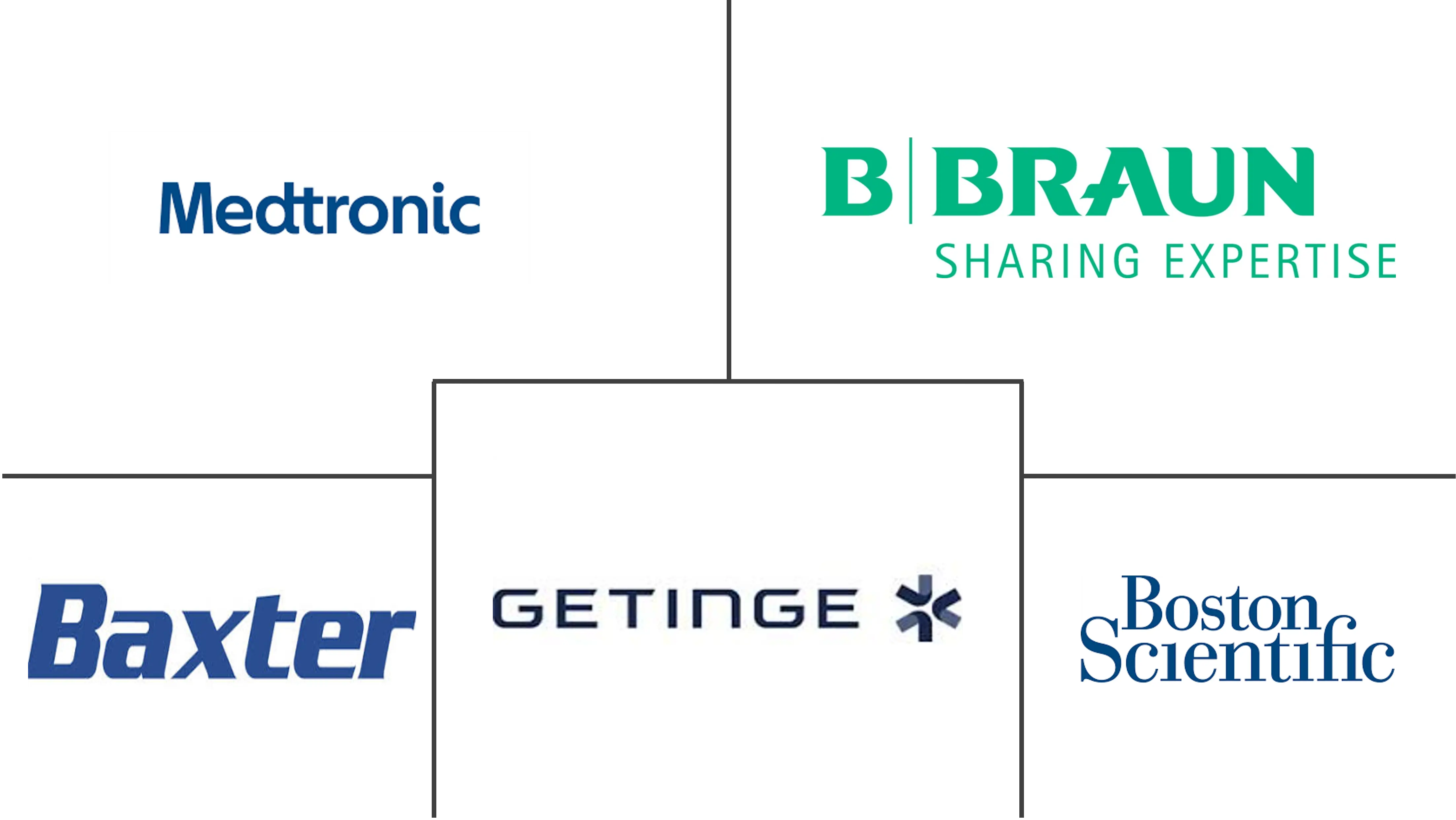Artificial Organ Market Size and Share
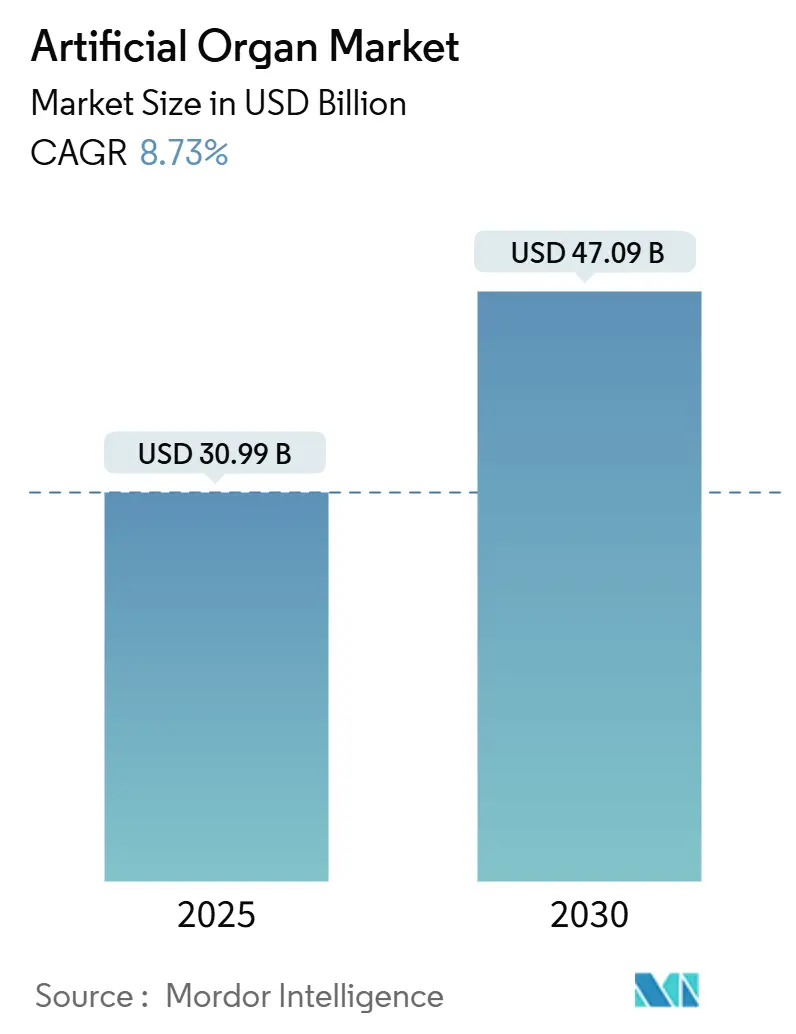
Artificial Organ Market Analysis by Mordor Intelligence
The artificial organs market is valued at USD 30.99 billion in 2025 and is on course to reach USD 47.09 billion by 2030, advancing at an 8.73% CAGR. Strong demand stems from the rapid rise in chronic kidney disease, heart failure, diabetes and respiratory disorders, all of which strain existing donor-organ supply. Breakthroughs in biocompatible materials, nano-scale fluid management and wireless sensors have lifted product reliability, eased implantation and improved long-term patient outcomes. Shifts in reimbursement policies, especially the introduction of accelerated approval routes for breakthrough devices, are shortening time-to-market while rewarding designs that cut hospital stays[1]U.S. House of Representatives Committee on Small Business, “Stifling Innovation hearing v05 06 2024,” congress.gov. Home-based care models, powered by remote monitoring platforms, are expanding clinical reach beyond large hospitals and enabling personalized therapy adjustments. Together, these forces position the artificial organs market for durable double-digit growth through the decade.
Key Report Takeaways
- By organ type, artificial kidney devices led with 57% of artificial organs market share in 2024, while the wearable artificial kidney segment is forecast to grow at 14.4% CAGR to 2030.
- By technology, mechanical solutions accounted for 67% revenue in 2024; electronic and bionic systems are projected to expand at 11.2% CAGR through 2030.
- By fixation method, fully implantable devices captured 74% of artificial organs market size in 2024, whereas externally worn systems are advancing at 15.8% CAGR from 2025-2030.
- By end user, hospitals with more than 300 beds held 68% share of artificial organs market size in 2024, home-care settings are set to register a 12.5% CAGR through 2030.
- By geography, North America accounted for a dominant 45% share of the artificial organs market in 2024. Meanwhile, the Asia-Pacific region is projected to achieve a robust 12.3% CAGR by 2030.
Global Artificial Organ Market Trends and Insights
Drivers Impact Analysis
| Driver | (~) % Impact on CAGR Forecast | Geographic Relevance | Impact Timeline |
|---|---|---|---|
| Increasing prevalence of chronic diseases and organ failure | +3.2% | North America, Europe, global | Long term (≥ 4 years) |
| Rising investment in research and development | +2.1% | North America, Europe, Japan, South Korea | Medium term (2-4 years) |
| Shortage of donor organs and ethical concerns | +1.8% | Global | Long term (≥ 4 years) |
| Growing aging population globally | +1.5% | Japan, Western Europe, North America, China | Long term (≥ 4 years) |
| Advancements in Technology and Biocompatibility | +2.4% | North America, Europe, advanced Asian economies | Medium term (2-4 years) |
| Patient Preference for Improved Quality of Life | +1.7% | Global, higher impact in developed regions | Medium term (2-4 years) |
| Source: Mordor Intelligence | |||
Increasing Prevalence of Chronic Diseases and Organ Failure
Kidney, cardiac and pulmonary diseases are climbing at rates that outpace organ donation, with 35.5 million adults in the United States already living with chronic kidney disease[2]Centers for Disease Control and Prevention, “Chronic Kidney Disease in the United States, 2023,” cdc.gov. End-stage renal disease treatment costs the US Medicare program USD 130 billion each year, pushing stakeholders toward durable artificial alternatives. Epidemiological modeling projects that up to 16.5% of the population in eight large economies will have chronic kidney disease by 2032, inflating dialysis demand by more than 75%. Similar pressures surface in cardiology, where a widening gap between listed transplant candidates and available hearts has pushed total artificial heart implant volume beyond 2,000 patients to date. As such, clinical urgency is directly feeding artificial organs market adoption.
Rising Investment in Research and Development
Federal grants, public-private alliances and venture capital are accelerating product pipelines. The National Institutes of Health awarded USD 459,824 in 2024 to refine the Wearable Artificial Kidney system, validating sustained public-sector support. Large med-tech firms are buying or partnering with niche innovators to gain access to 4D bioprinting and magnetically levitated pumps, while the broader biotechnology segment is forecast to reach USD 3.2 trillion by 2030. Capital is concentrating on miniaturization, hemocompatible coatings and AI-enabled control algorithms, key differentiators in the artificial organs market.
Shortage of Donor Organs and Ethical Concerns
Waiting lists extend by months whenever supply shrinks, with a 10% rise in the kidney list lengthening average wait by four months. Ethical debates on allocation fairness and xenotransplantation are pushing clinicians toward fully synthetic routes. Total artificial heart systems such as SynCardia and next-generation devices from CARMAT or BiVACOR address immediate life-threat scenarios without immunosuppression, boosting confidence among surgeons and payers.
Growing Aging Population Globally
Population aging is most pronounced in Japan, Western Europe and parts of China, regions where organ failure incidence escalates sharply after age-65. Older patients often present comorbidities that complicate donor organ compatibility, positioning long-duration mechanical circulatory support and implantable artificial kidney devices as essential. As life expectancy rises and birth rates fall, healthcare systems re-prioritize funding toward chronic-care technologies, effectively expanding the artificial organs market footprint.
Restraints Impact Analysis
| Restraint | (~) % Impact on CAGR Forecast | Geographic Relevance | Impact Timeline |
|---|---|---|---|
| High cost of artificial organs and procedures with limited reimbursement | −1.9% | Global, stronger in emerging markets | Medium term (2-4 years) |
| Device longevity and biocompatibility issues | −1.2% | Global | Short term (≤ 2 years) |
| Limited awareness and skilled healthcare professionals | −0.8% | Asia-Pacific, Latin America, Africa | Medium term (2-4 years) |
| Complex Surgical Procedures | −1.1% | Global, higher impact in regions with limited healthcare infrastructure | Medium term (2-4 years) |
| Source: Mordor Intelligence | |||
High Cost of Artificial Organs and Procedures Coupled with Limited Reimbursement Options
Total artificial hearts can exceed USD 200,000 per implant, and reimbursement frameworks vary widely, especially in low-income economies. Payers often require extensive real-world evidence before assigning permanent billing codes, slowing uptake. Trade groups now lobby regulators to formalize payment pathways, as outlined in a 2025 AI Policy Roadmap that calls on Medicare to reward life-cycle cost savings. Innovative value-based contracts are beginning to emerge but remain too scarce to offset near-term pricing pressure on the artificial organs market.
Device Longevity and Biocompatibility Issues
Thrombosis, infection and early material failure create revision risk and add cost. Research on nitric-oxide-releasing surfaces and hydrophilic coatings shows progress, yet many next-generation lungs, pancreases and liver constructs are still limited to investigational use. Longer-term durability evidence is critical for surgeons and insurers before routine deployment can accelerate.
Segment Analysis
By Organ Type: Artificial Kidney Dominates While Wearable Solutions Surge
The artificial kidney segment generated 57% of artificial organs market revenue in 2024, driven by the expanding chronic kidney disease population and the entrenched dialysis ecosystem. Growing preference for continuous renal replacement in outpatient settings keeps device utilization high. The artificial organs market size for wearable kidney systems is forecast to climb at a 14.4% CAGR from 2025-2030, supported by portable nanoelectrokinetic modules that permit 8-10 hours of daily mobility. Early clinical studies highlight improved patient satisfaction when therapy shifts from clinic-bound sessions to ambulatory self-care.
Clinicians are also trialing combined toxin removal and hormone-replacement cartridges, broadening indications beyond end-stage disease. Artificial pancreases are next in line, benefiting from mature continuous glucose monitors and closed-loop insulin pumps. Meanwhile, artificial lungs gained visibility during the COVID-19 crisis, and bio-artificial liver prototypes target acute fulminant hepatic failure. Together, these innovations diversify revenue streams and reduce reliance on a single dominant organ segment within the artificial organs market.
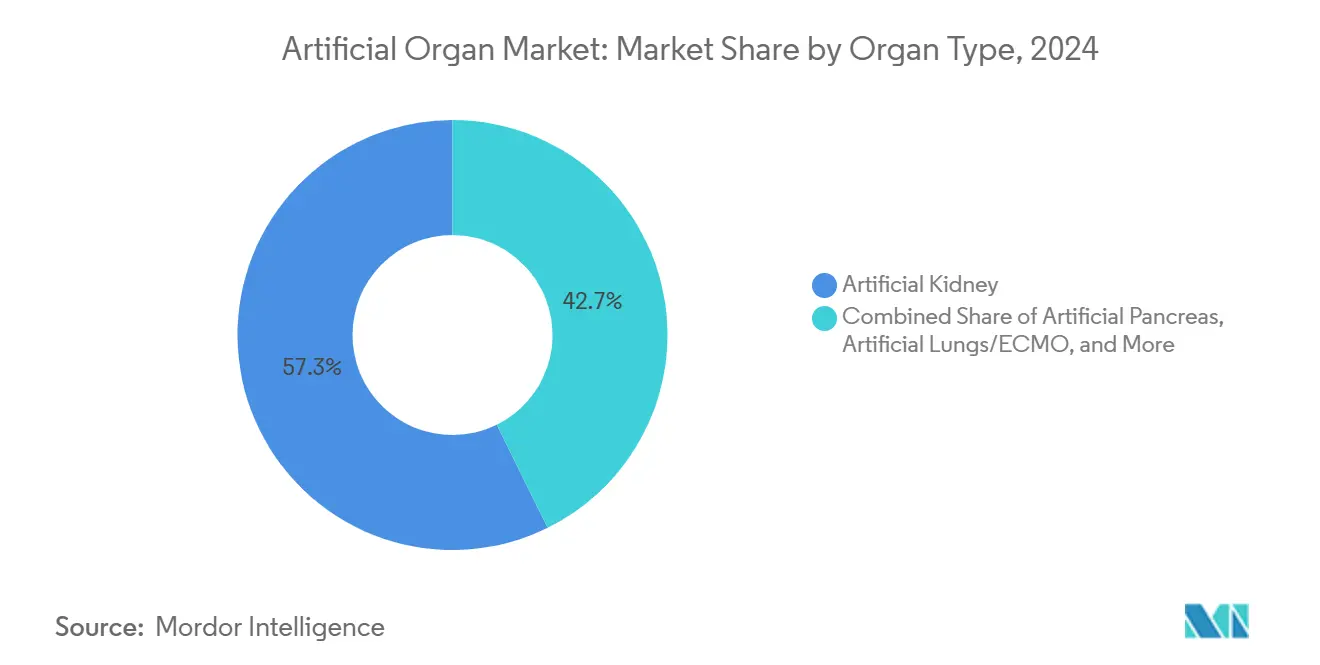
Note: Segment shares of all individual segments available upon report purchase
By Technology: Mechanical Solutions Lead While Electronic Innovations Accelerate
Mechanical platforms held 67% of 2024 revenue due to established clinical protocols and proven safety profiles. Dialysis machines, membrane oxygenators and centrifugal pumps remain hospital workhorses. Yet electronic and bionic architectures are scaling fast, and this sub-segment is predicted to grow at 11.2% CAGR through 2030. Smart sensors, closed-loop software and on-board power management allow dynamic flow regulation and real-time clot detection, properties now expected in premium cardiac support devices. As a result, hospital purchasing criteria increasingly consider connectivity and AI analytics, a shift that places electronic innovators at the center of artificial organs market momentum.
Vision-guided 4D bioprinting sits at the frontier, promising personalized soft-tissue grafts with microvascular networks. Success here would bring fully cellularized organs closer to mass-customization, bridging mechanical and biological paradigms.
By Fixation Method: Fully Implantable Devices Predominate While External Solutions Gain Momentum
Fully implantable systems commanded 74% share in 2024 since they lower infection risk and simplify patient routines. Integration of on-board physiologic sensors has improved complication detection, extending in-body dwell time well past five years for several ventricular assist devices. However, the externally worn category is growing at 15.8% CAGR as lightweight power packs and wireless controllers unlock home-care possibilities. For patients ineligible for open-chest surgery, percutaneous devices present a safer bridge-to-transplant path. As wireless energy transfer improves, the artificial organs market is expected to witness convergence between fully implantable and partially external platforms, balancing convenience, longevity and procedural risk.
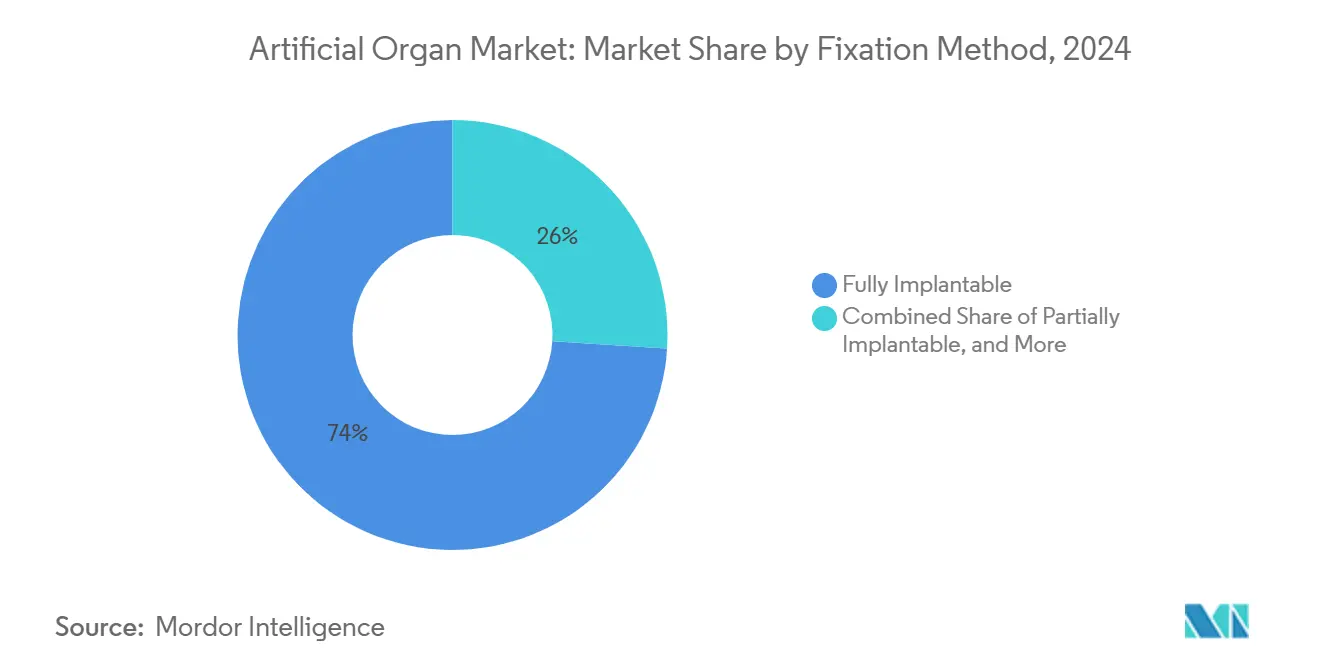
Note: Segment shares of all individual segments available upon report purchase
By End User: Large Hospitals Lead While Home-care Settings Expand Rapidly
Hospitals above 300 beds accounted for 68% of artificial organs market size in 2024, reflecting their multidisciplinary teams, intensive-care capacity and reimbursement alignment. Complex implants such as total artificial hearts demand surgeons, perfusionists and bioengineers who usually cluster in tertiary centers. That said, the home-care segment is expected to rise at 12.5% CAGR due to cloud-linked monitoring dashboards that alert clinicians to pressure changes, alarm triggers or voltage drops. Smaller community hospitals and ambulatory surgical centers follow suit as plug-and-play components reduce case complexity. In emerging economies, tele-mentoring platforms are helping to bridge skills gaps, giving more institutions a pathway into the artificial organs market.
Geography Analysis
North America held 45% of global revenue in 2024, anchored by robust Medicare coverage for life-sustaining devices and a large installed base of dialysis clinics. The United States alone represents 40% of worldwide medical device consumption, with an extensive pipeline of FDA breakthrough-designated implants facilitating faster commercialization[3]Food and Drug Administration, “DHAC Nov. 20 2024 Transcript,” fda.gov. Payer pilots now reimburse remote monitoring on a per-member-per-month basis, encouraging migration from hospital to home.
Asia-Pacific is the fastest growing region, advancing at a 12.3% CAGR through 2030. China and India are scaling universal health-insurance coverage, and national procurement programs are negotiating bulk prices for dialysis cartridges and ventricular assist devices. Population aging in Japan accelerates cardiac support demand, while South Korea’s well-funded R&D incentives help local firms export miniaturized drive systems. Local manufacturing cuts cost by up to 30%, broadening access and propelling artificial organs market adoption across mid-income segments.
Europe remains influential, thanks to uniform quality standards under the Medical Device Regulation. Germany and the United Kingdom drive early adoption of bioprosthetic heart valves and long-wear insulin pumps, whereas newer European Society for Organ Transplantation initiatives seek to harmonize advanced-therapy reimbursement. Economic constraints persist, yet coordinated procurement at the EU level is expected to support wider diffusion across Southern and Eastern member states.
Middle East and Africa plus South America account for a smaller slice of revenue. Uptake is strongest in Saudi Arabia, the United Arab Emirates, Brazil and South Africa, where private networks finance sophisticated implants. Public hospital budgets remain under pressure, but strategic partnerships with multinational device suppliers are improving clinician training and warranty coverage. Over the forecast horizon, multicenter tele-ICU hubs and cross-border service models should narrow the accessibility gap, lifting regional participation in the artificial organs market.
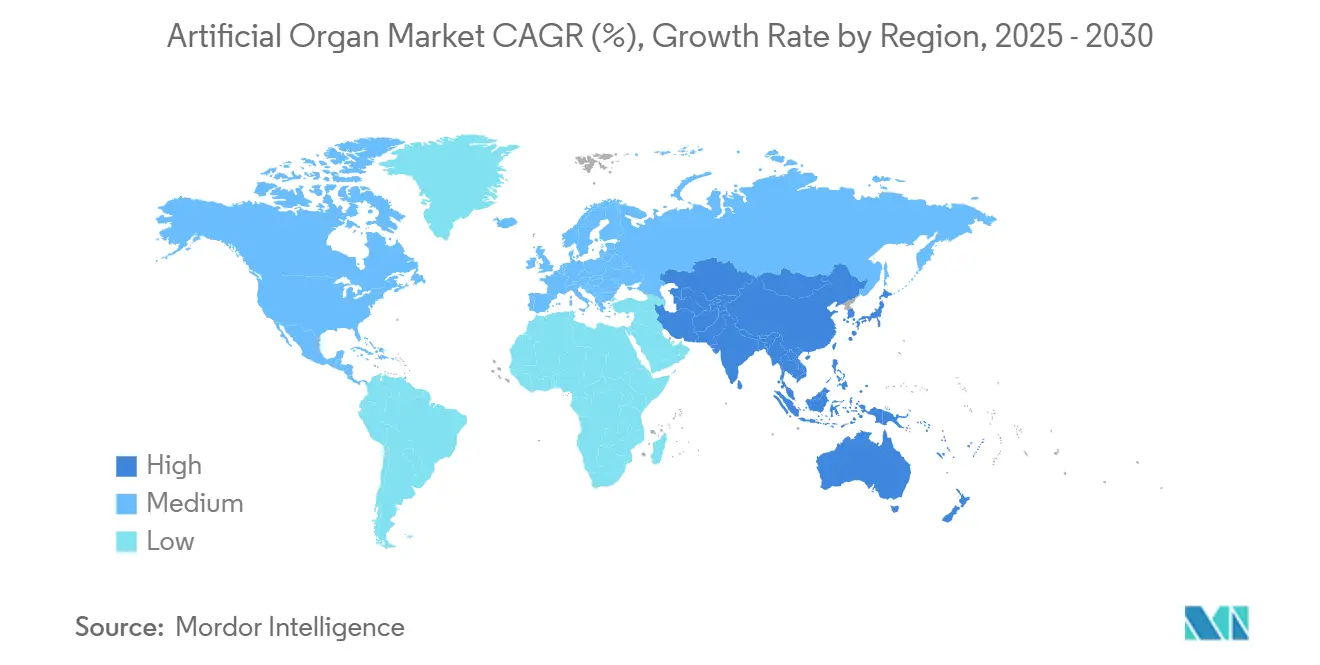
Competitive Landscape
The artificial organs market features a mix of diversified conglomerates and focused specialists. Medtronic, Abbott and Boston Scientific leverage global distribution and multi-product portfolios to negotiate bundled contracts with health systems. Medtronic’s launch of the Avalus Ultra surgical valve in 2024 expanded its cardiac toolkit with a lower profile yet larger effective orifice area, aiding surgeon handling. Abbott’s robotics-assisted HeartMate 3 implant in early 2025 showcased the merger of surgical automation and magnetically levitated pump technology, setting a benchmark for minimally invasive implantation.
Specialists lead radical innovation. CARMAT’s bioprosthetic heart deploys bovine pericardium contact surfaces to limit thrombosis and uses adaptive flow software for physiologic response. BiVACOR refines axial-levitation to reduce shear stress on blood cells, a critical safety differentiator. Start-ups pursuing bioartificial kidney and liver constructs rely on 4D-printed scaffolds seeded with autologous cells, aiming for immunosuppression-free function.
Mergers, licensing and equity partnerships remain common as incumbents seek rapid entry into high-growth sub-niches. Regulatory data exclusivity and patent thickets protect margins, yet payers demand cost justification. Companies therefore bundle analytics dashboards that quantify readmission reduction and therapy adherence, stacking economic evidence in reimbursement dossiers and strengthening positioning within the artificial organs market.
Artificial Organ Industry Leaders
-
Baxter International Inc.
-
Boston Scientific Corporation
-
Getinge AB
-
Medtronic PLC
-
B. Braun Melsungen AG
- *Disclaimer: Major Players sorted in no particular order
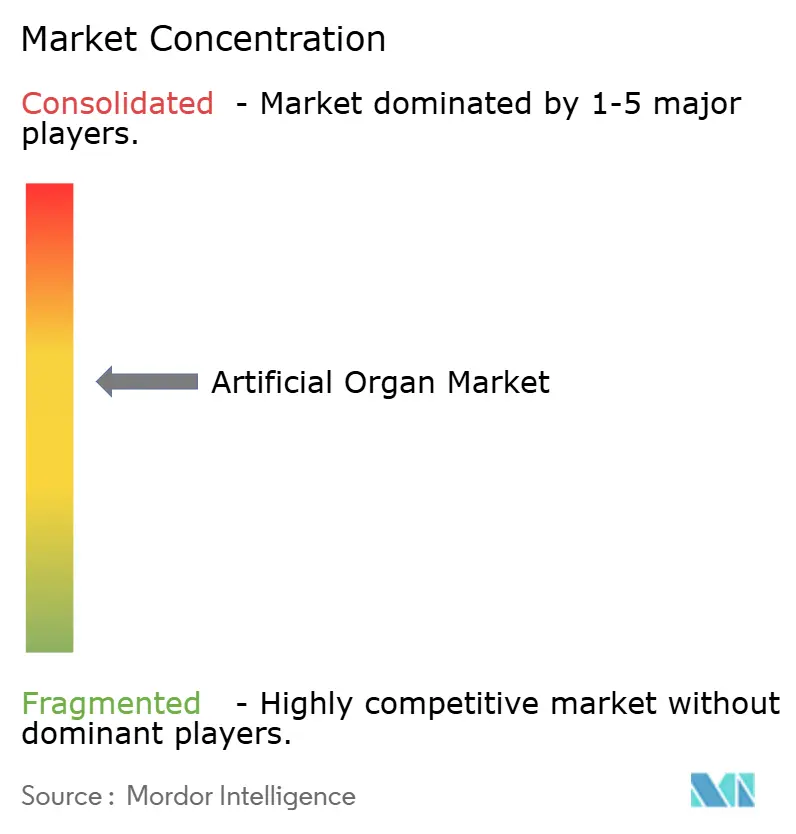
Recent Industry Developments
- March 2025: Abbott obtained CE Mark for its Volt Pulsed-Field Ablation system after demonstrating 99.1% pulmonary vein isolation, intensifying competition in the atrial-fibrillation treatment arena
- January 2025: Surgeons in Saudi Arabia performed the first robotic implant of Abbott’s HeartMate 3, underscoring adoption of advanced surgical robotics to improve precision and reduce recovery time.
- July 2024: The National Kidney Foundation highlighted progress on an implantable artificial kidney poised to provide continuous filtration for stage 3-4 kidney disease patients.
- April 2024: Medtronic introduced the Avalus Ultra aortic tissue valve, featuring a PEEK base for circularity retention and a large effective orifice to boost forward flow.
Research Methodology Framework and Report Scope
Market Definitions and Key Coverage
Our study defines the artificial organs market as revenue from implanted, partially implanted, or externally connected devices that restore or augment lost function of the heart, kidney, liver, lungs, pancreas, or sensory organs. The modeled basket covers ventricular assist devices, prosthetic heart valves, cochlear and retinal implants, wearable artificial kidneys, extracorporeal oxygenation circuits, and early 3-D-bioprinted constructs.
Pure biologic grafts, routine prosthetic limbs, and research-only prototypes sit outside the model.
Segmentation Overview
- By Organ Type
- Artificial Heart
- Prosthetic Heart Valves
- Ventricular Assist Devices
- Cardiac Pacemakers & ICDs
- Artificial Kidney
- Implantable Devices
- Wearable / Portable Systems
- Artificial Pancreas
- Artificial Lungs/ECMO
- Cochlear & Auditory Brain-stem Implants
- Bio-artificial Liver
- Other Organs (Cornea, Spleen, Bladder, Trachea)
- Artificial Heart
- By Technology
- Mechanical
- Electronic / Bionics
- Wearable / Externally Worn
- 3D-Bioprinted Constructs
- By Fixation Method
- Fully Implantable
- Partially Implantable
- Externally Worn / Percutaneous
- By End User
- Hospitals (>300 Beds)
- Hospitals (<300 Beds)
- Ambulatory Surgical Centers
- Home-care & Remote Monitoring
- Geography
- North America
- United States
- Canada
- Mexico
- Europe
- Germany
- United Kingdom
- France
- Italy
- Spain
- Rest of Europe
- Asia-Pacific
- China
- Japan
- India
- South Korea
- Australia
- Rest of Asia-Pacific
- Middle East and Africa
- GCC
- South Africa
- Rest of Middle East and Africa
- South America
- Brazil
- Argentina
- Rest of South America
- North America
Detailed Research Methodology and Data Validation
Primary Research
We interviewed transplant surgeons, biomedical engineers, payer advisers, and hospital procurement heads across North America, Europe, and Asia-Pacific. Their views on treated-patient ratios, device lifespans, and regional price corridors grounded the model's assumptions.
Desk Research
Mordor analysts began with open datasets such as UNOS transplant waiting lists, OECD dialysis prevalence, WHO health-spend tables, and HS codes in UN Comtrade, and then layered insights from the American Society for Artificial Internal Organs, Eurotransplant, patent abstracts via Questel, listed-company 10-Ks, and Dow Jones Factiva news archives. These illustrate the sweep; many other references underpinned interim checks.
Market-Sizing & Forecasting
A top-down prevalence-to-treated cohort build converts chronic organ-failure statistics into device demand. Select bottom-up supplier roll-ups and sample ASP × volume checks validate totals. Drivers such as dialysis penetration, VAD implant rates, ECMO installed base, 3-D-bioprinter throughput, reimbursement coverage, and dollar-euro shifts feed a multivariate regression with scenario overlays through 2030.
Data Validation & Update Cycle
Independent reviewers scan outputs against transplant volumes, hospitalization data, and listed-company revenues before sign-off. Reports refresh annually, with mid-cycle tweaks for major approvals or code changes, and a last-mile analyst pass ensures clients receive the latest baseline.
Why Our Artificial Organ Baseline Commands Reliability
Published values often diverge because firms mix device baskets, pricing lenses, and refresh cadences.
Our patient-cohort anchoring, disciplined scope, and yearly hygiene deliver a dependable benchmark.
Benchmark comparison
| Market Size | Anonymized source | Primary gap driver |
|---|---|---|
| USD 30.99 B (2025) | Mordor Intelligence | - |
| USD 30.52 B (2025) | Global Consultancy A | Includes rehab prosthetics yet omits dialysis service fees |
| USD 35.30 B (2024) | Trade Journal B | Uses global ASP uplift without import verification |
| USD 23.95 B (2025) | Regional Consultancy C | Excludes emerging Asia and applies 2023 currency averages |
Taken together, the comparison shows that Mordor's transparent variables and repeatable steps give decision-makers the most balanced starting point.
Key Questions Answered in the Report
What is the current size of the artificial organs market?
The artificial organs market stands at USD 30.99 billion in 2025 and is projected to reach USD 47.09 billion by 2030.
Which organ segment holds the largest artificial organs market share?
Artificial kidney devices led with 57% share in 2024, reflecting the heavy burden of chronic kidney disease.
Which region is growing fastest in the artificial organs market?
Asia-Pacific is advancing at a 12.3% CAGR through 2030 due to expanding healthcare access and rising chronic-disease prevalence.
How are home-care models influencing demand?
Externally worn and remotely monitored devices are growing at 15.8% CAGR as payers and patients favor therapies that reduce hospital stays.
What are the key barriers to wider adoption of artificial organs?
High upfront device costs, limited reimbursement pathways and lingering biocompatibility challenges constrain uptake, especially in emerging markets.
Which companies are leading innovation in artificial hearts?
CARMAT and BiVACOR are notable for bioprosthetic surfaces and magnetically levitated pumps that aim to improve hemocompatibility and durability.
Page last updated on:
